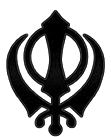| Sikhism |
 |
The Sikh religion emerged during the early 16th century in the state of Punjab in North India. The founder of this faith was Guru Nanak, who from his childhood was attracted to both Hindu and Muslim saints. Born a Hindu, but also inspired by the teachings of Islam , he began to preach the message of unity of both religions. According to him, the basic teachings of both faiths were essentially the same. Nanak attracted many followers and came to be known as a Guru or a teacher. His disciples came together to form a new religious tradition called Sikhism.
The Gurus who followed Nanak contributed to the consolidation and spread of Sikhism. The teachings of Guru Nanak were incorporated in the 'Guru Granth Sahib', the Holy Book of the Sikhs which became a symbol of God for Sikhs. The fifth Guru, Guru Arjun built the Golden Temple at Amritsar which became the holiest of Sikh shrines. The tenth Guru, Govind Singh imparted military training to the Sikhs to help them defend themselves.nt>
|
 |
On Baisakhi day of 1699 at Anandpur, Guru Govind Singh ordered his Sikhs to assemble before him as was customary and created a new brotherhood of Sikhs called the Khalsa (Pure Ones). Five men selected for their devotion to the Guru were called Panj Pyares and given nectar (amrit) for initiation into the brotherhood of Khalsa. Later the Guru himself received initiation from Panj Payares as did others. |
The members of the new brotherhood were instructed to wear the five symbols (the five Ks )- uncut hair, a comb, a steel wrist guard, a sword and breeches. The initiated men took the name Singh (Lion) and the women Kaur (Princess). The Guru also decided to terminate the succession of gurus and was thus the last of the Sikh Gurus.
Sikhism propounds monotheism, i.e. worship of one God. It also opposes the caste system and believes that all men are equal. However the ideas of karma and rebirth from Hinduism are accepted. Today, many Sikh practices are common to Hindus. Intermarriages between the two communities are also common. However the Sikh community has its own unmistakable identity. Though the Sikhs constitute less than 2 percent of the Indian population, they have become a distinct element in the configuration of the Indian religious tradition and the Indian society.
|
|
|
| Festivals |
The Indian calendar is one long procession of festivals. These are as varied in origin as they are large in number. There are innumerable national, regional, local, religious, seasonal and social festivities. This is not surprising considering the fact that India is the land of gods, goddesses, saints, gurus and prophets.
Festivals here are characterised by colour, gaiety, enthusiasm, feasts and a variety of prayers and rituals. Travellers are struck by the scale and multiplicity of the festivities that populate the cultural scene of this land.
|
| Read more about Indian Festivals |
|
|
